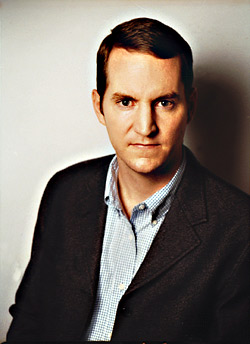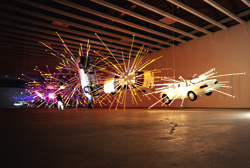The most recent exhibit Los Angeles art curator Michael Darling saw at the Seattle Art Museum was by sound and sculpture artist Christian Marclay. That was back in the spring of 2004. SAM, it would seem, is not necessarily a museum that out-of-towners feel compelled to visit regularly—even those actively involved in the art world.
As SAM’s newly appointed curator of modern and contemporary art, Darling, 38, will soon be spending a lot more time there, and he hopes to help make it a destination for others, too. “It definitely has a reputation as being a good general museum. For someone in the contemporary art field, it has less of a reputation,” he admits diplomatically. “I’d like to increase the profile of SAM on an international and national stage.”
Darling was hired by the L.A. Museum of Contemporary Art (MOCA) in 1998 as a research assistant. In eight years, he has worked his way up to assistant and then associate curator at MOCA, and now to this new position at SAM, which brings him here in July. Not bad for a former L.A. Weekly art critic.
“He came to our attention when I began to explore who were the most talented curators in the field of modern and contemporary art,” says Museum Director Mimi Gardner Gates. “We were looking internationally, and many of his peers mentioned his name. He is very highly thought of in his field.
“He is also well-grounded in the history of art, and the art and artists of the 20th century,” says Gates. “In a general museum, it enables you to work seamlessly with colleagues.” And, she adds, “He’s wonderful with artists.”
“He’s a swell guy. A very nice man,” says Los Angeles Times art critic Christopher Knight, who has been reporting on the L.A. art scene for 26 years. Will Darling bring a much-hoped-for edge to SAM? “‘Edge’ is not the word I’d use,” says Knight. “He is incredibly thoughtful, very smart, works like a dog. A great asset.” Seattle will be his proving ground.
As one of seven curators at MOCA fighting for “calendar space,” Darling has been able to conceive his own shows about twice a year. “The exhibits he has organized are impressive,” says Gates. “I really like his range that goes from painting to design to architecture.”
His own curatorial portfolio includes “Painting in Tongues,” a show of six emerging artists which just closed, a Roy McMakin exhibit, and “The Architecture of R.M. Schindler.”These are all respectable efforts, but none was a blockbuster. Will his shows at SAM be new, provocative, edgy? “Definitely provocative,” says Darling. “That doesn’t necessarily mean new. It could be a provocative view on a historical period. I always like that an artist has a sense of tradition and the past.” If this sounds a little too respectful, he insists, “Sometimes you have to kill off your father figure to make something new. I respect artists who take that route as well.”
He’s confident that Gates and SAM will give him the autonomy he needs to take the reins boldly. He is free of some of the administrative duties that sandbagged the job when Lisa Corrin held the post and oversaw the development of the Olympic Sculpture Park and the museum’s expansion. “Lisa Corrin did a lot of the dirty work, and now I get to inherit the sculpture park and great new spaces.”
Gates says Darling will have “the freedom to fly.” This comment and the museum’s acquisition of Cai Guo-Qiang’s nine somersaulting and light-sparking Ford Tauruses, Inopportune: Stage One, are positive signs that SAM may be waking from its slumber and giving the city something to be excited about.
So far,Darling has visited Western Bridge, Howard House, Greg Kucera, and James Harris—not a bad start for a contemporary sampling of Seattle’s art scene. While he admits he’s got some catching up to do, he’s able to rattle off an impressively long list of local art collectors whose holdings he’d be interested in tapping. “There’s some fantastic art in private collections there.”
SAM’s 2007 reopening coincides with its 75th anniversary, so Darling is arriving at a high-profile time for the museum. “Mimi and [Deputy Director of Art] Chiyo [Ishikawa] made a fantastic case for the future of SAM. I feel very fortunate.” He walked through the new space earlier this year, which “helped seal the deal for me.”
“There’s a lot of space to work with,” he says, including a traditional square white gallery. “I like my nice white cube,” he says fondly, clearly in his comfort zone. Meanwhile, some contemporary galleries and artists are trying to break out of this particular box—Scott Lawrimore, for example, plans to have one in his new space only to play with it ironically. Darling sounds, in short, like a safe bet for Gates and SAM. Let’s hope not too safe.








